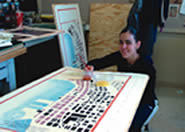
Graduates from the School of Architecture had to work awfully hard this year not to get a job. Eighteen firms purchased a $20 CD-ROM collective portfolio the school produced to feature students’ work. Another 65 firms showed up at the 2007 career fair in March. All to woo a pool of 52 undergraduates and master’s candidates.
That intense talent trawling appears to be unheard of among architecture programs. But it’s not so unusual for Notre Dame. Architecture Dean Michael Lykoudis says demand for graduates’ services grows each year. The economic downturn a few years ago meant students had just one job offer when they finished school, instead of the two or three that other classes enjoyed. No wonder Arkies seem especially gleeful at commencement.
Lykoudis acknowledges that the evidence of Domers’ comparative advantage is, for now, anecdotal though plentiful, based on unofficial feedback from colleagues at other prominent programs. Architecture schools tend not to share the hard data that reveals how their students are faring in the marketplace. But he says Notre Dame plans to gather salary information from recent graduates and former students five and 10 years into their careers and compare it to city-by-city data compiled by the American Institute of Architects.
Architect Scott Merrill says 11 of his Vero Beach, Florida, firm’s 14 architects are Notre Dame graduates hired since 1994. “We are grateful to come away with one graduating student,” he says. Notre Dame has done something “even more remarkable—they have established a labor sub-market where they get higher offers than do graduates of other programs.”
What sets Notre Dame students apart, Lykoudis says, is their classical training. Plus, they know how to draw and have great presentation skills.
In short, Notre Dame’s revivalist niche as a proving ground for classically trained and craft-minded architects is positioning its students for success. “Most curricula rely exclusively on computers, so [students] won’t learn to draw,” Lykoudis says. “The cognitive process of drawing something by hand versus drawing it by computer is very different. The way you see space, you feel space, by drawing it is a completely different cognitive skill set than snapping lines and connecting dots.”
The difference is practical, too. A Domer can meet with a client and produce a watercolor sketch while they talk, while another colleague would likely have to return to the office and email a computer-assisted drawing within a couple of days.
“The fact is that they not only do superior drawings, but they are quite clear on how they are assembled,” says Merrill, who sat on a jury evaluating fifth-year students’ work in the spring. “Students spoke with equal authority on urban design and structure and mechanical systems. The documentation was astonishingly thorough.”
Of course Notre Dame doesn’t enforce technological illiteracy. Students start formal computer work during their fourth year. By that time, they have already spent their year in Rome and made formal urban design proposals to city officials in Italy.
“Then they come back here, and we go to American cities,” Lykoudis says. “They have skills that are about building real things and about contributing to the future, thinking about environmental issues, thinking about political issues. Their classical training brings all of those things together.
“The real credibility of our program is based on the fact that, as a Catholic institution, we value the notion of community. If a Catholic institution values community, it ought to know how to build it. That’s what we talk about,” he says.